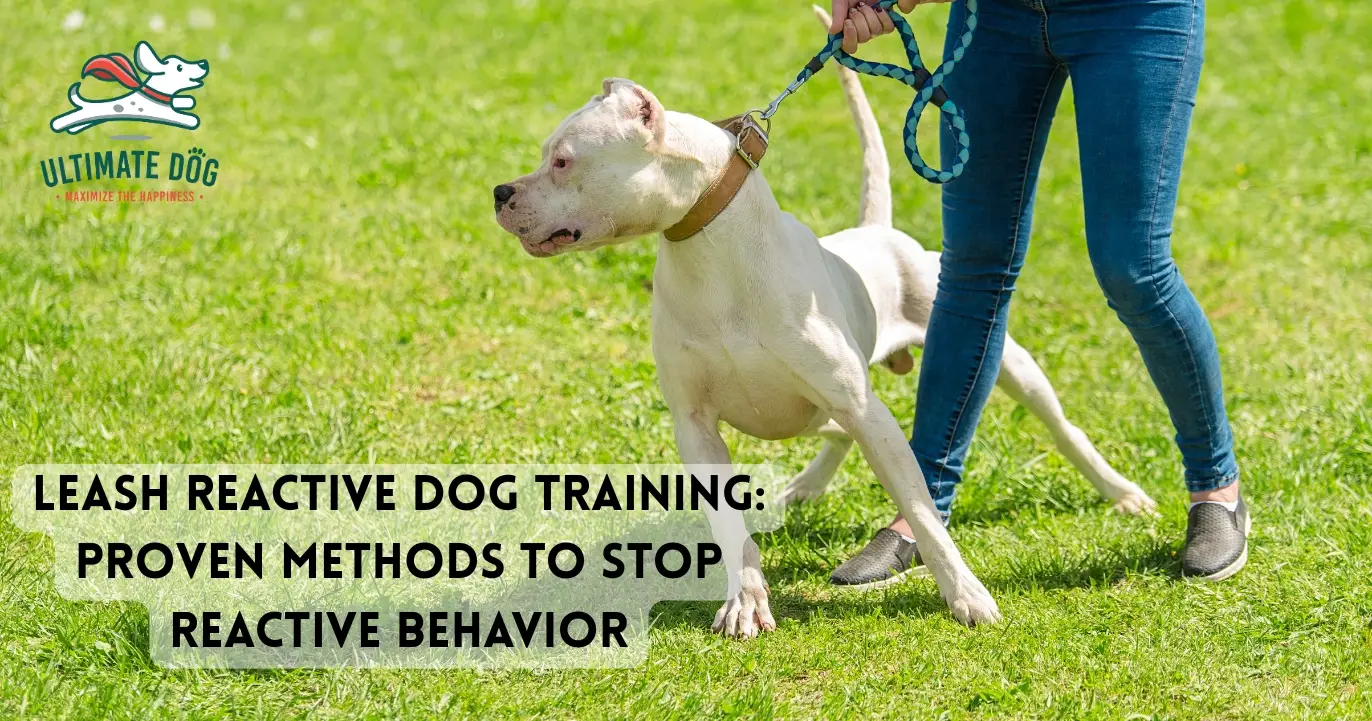There’s nothing more relaxing than a beautiful sunset stroll with your dog. Unless, of course, you have a leash-reactive dog, in which case, dog walks are likely the least relaxing activity you can think of.
If this all sounds too familiar, don’t fret. If this all sounds too familiar, don’t fret. I have worked with numerous leash-reactive dogs, and I am here to share my effective tips for addressing and stopping leash reactivity.
With a clear understanding of how leash reactivity develops, it is possible to help your dog overcome this issue to bring peace back to your walks. In this article, we’ll look at the different causes of leash reactivity in dogs, how to address them, and some helpful tips for making walking more enjoyable in the meantime.
What Is Leash Reactivity?
Leash-reactive dogs are dogs who lunge, bark or growl at passing dogs, people, bikes, cars, or other specific triggers. This behavior often seemingly starts out of nowhere, though leash reactivity can develop after a specific incident.
For instance, I had a client whose dog developed severe leash reactivity to women in hats after the owner tried loose leash training using a shock collar. The dog, most likely, associated the shock with a passerby who happened to be wearing a hat.
Why Do Dogs Develop Leash Reactivity?
If you have a leash-reactive dog, know that you are not alone. This is one of the most common issues I worked with during my time as a behavior modification trainer. During that period, I found that most dogs develop leash reactivity for one of four reasons.
Excitement (aka Frustration)
Many leash-reactive dogs develop this issue simply because they get too excited about seeing dogs or people on walks. Now, you might be asking, if my dog is so excited to see these things, then why do they sound like they want to rip that person or dog into pieces? The answer is simple: frustration.
When your dog sees a person they want to meet or a dog, they want to play with, and their leash prevents them from approaching, their frustration levels can skyrocket. This can turn excited whining or jumping into fierce-sounding barking or lunging. And the more often they get frustrated by passersby, the more out of control this behavior is likely to get.
To determine if excitement is the root of your leash-reactive dog’s issues, ask yourself:
- If my dog is allowed to go up to the dog or person they are reacting to, do they happily greet that dog or person?
If the answer is yes, then they very likely have excitement-based leash reactivity.
Fear
By far, the most common cause of leash reactivity, in my experience, is fear. This surprises many owners, largely because the thing they react to on leash—people or other dogs—is not something the dog is usually afraid of in other situations.
For example, when I managed a dog daycare, we had many doggy customers who would lunge and bark at other dogs while on leash in the lobby but would play happily with everyone once in the play yards. Many owners attribute this contradictory behavior to their dogs being possessive of them. The truth is, it’s not the owner causing the issue, but the leash.
In order to greet one another properly, dogs need space and freedom to move. The leash takes both of these away. Being on a leash can also cause your dog’s or the other dog’s body language to be stiffer, which gives the impression of aggression, which only adds to the problem. All of this can cause a normally social dog to act or react defensively to other dogs when on a leash and develop leash reactivity.
Another way fear-based leash reactivity behavior manifests is after a dog realizes they can’t flee. Most dogs figure this out after an off-leash dog or overly eager person invades their space, and the leash keeps them from retreating. Some dogs develop leash reactivity after being attacked by another dog while on a walk.
Most dogs develop leash reactivity toward humans or dogs on walks simply because they are aware they won’t be able to get away should that person or dog turn into a threat. Because they know fleeing is not an option, fear-reactive dogs take an offensive approach to passing people or dogs. They think that by presenting themselves as a threat, they can scare away the thing they are afraid of.
To determine if fear is causing your dog’s leash reactivity, ask yourself:
- Is my dog less reactive or nonreactive to the trigger when off leash? If the trigger is allowed to approach, does my dog try to flee or act defensively?
If the answer to these questions is yes, then you are likely dealing with a fear problem.
Aggression
In my time as a professional dog trainer and behavior consultant, I worked with a lot of owners frustrated over their leash-reactive dog’s behavior. When I asked these owners to describe their dog’s behavior on walks, the term “leash aggression” was frequently thrown around. In fact, most owners believe their dog’s leash reactivity is caused by aggression. In other words, they think their dog actually wants to attack the thing they are barking and lunging at.
In my experience, this is almost never the case. To find out if your dog is one of the few canines that shows true leash aggression, ask yourself:
- Does your dog act aggressively toward dogs or people when off-leash?
If the answer is no, then aggression is very unlikely to be the cause of their leash reactivity. If the answer is yes, then you have a serious issue on your hands, and I highly recommend enlisting the help of a canine behavioralist. And in the meantime, consider walking your dog with a basket muzzle to keep them and everyone else safe.
Instinct
Most leash reactivity occurs in reaction to other dogs or strangers. But other things can trigger reactive behavior, too.
Bikes, cars, and prey animals are other common triggers for dogs. But, typically, the reason dogs lunge and bark at these objects is more a matter of instinct than fear or simple excitement.
Dogs react to bikes and cars because they move fast, which triggers their chasing instinct. And dogs react to bunnies and birds simply because they trigger their prey drive. Any time a dog is restricted from engaging in instinctual drives by a leash, they are likely to get frustrated and begin displaying leash reactivity behaviors similar to what is seen with excitement-based leash reactivity.
How to Train a Leash Reactive Dog
Now that we know what is causing your dog’s leash reactivity, we can begin manipulating their perception to change their behavior. This is best done with counter-conditioning.
There are a few different ways to approach this type of leash-reactive dog training, but I’ve found the exercise below to be the most effective for owners working with their dogs without the help of a professional trainer. This exercise should be done every time your dog is on a leash around others. It can take days to months to get through all the steps, depending on how reactive your dog is. The key is not to rush it and to work at your dog’s pace.
Counter Conditioning for Leash Reactivity
Training leash-reactive dogs using this exercise works for both fear- and excitement-based leash reactivity issues because it changes your dog’s perception of the trigger. No longer is that passing person a threat or a new friend that needs to be greeted immediately. Instead, the trigger becomes a simple cue that tells your dog to pay attention to you.
Note: This leash reactivity exercise is best done, at least in the beginning, with a helper who can continuously pass by your dog as needed. If your dog is reactive to dogs, this helper needs to have a dog your dog will react to. If your leash-reactive dog reacts to people, this helper needs to be a person your dog will react to. If you don’t have a helper, you can use real-world walk situations so long as you have control over the distance between your dog and the triggers.
- Find your dog’s threshold. Every leash-reactive dog has an “under-threshold (UT) distance”—the closest distance at which your dog does not react to the trigger. The first step in training is to determine how far from the trigger you need to be to avoid a reaction.
- Begin counter-conditioning (CC) with high-value treats. Working at your UT distance, stand with your dog and wait for them to notice the trigger walking by. As soon as they look at the trigger, start continuously feeding them high-value treats, such as cheese, lunch meat, boiled chicken, or freeze-dried liver, until the trigger has passed. Your dog can be standing or sitting for this part of the exercise.
- Continue CC until a new association is made. Repeat the above step at least a dozen times with different passes from your helper or different people/dogs. After numerous repetitions, let your dog see the trigger, but don’t immediately offer treats. If your dog looks at the trigger and then looks at you, it means they have built a new association. Instead of “trigger = threat/new friend,” they have now learned “trigger = treats.” If your dog has not made the association, repeat the previous step a dozen more times and then test again.
- Reduce your distance. Repeat the process of treating every time your dog looks at the trigger and then looks at you while, at the same time, reducing the distance between them and the trigger. Move slowly here. The goal is to get within a normal passing distance of the trigger without your dog ever reacting. If they do react at any given distance, move back to the last distance they were comfortable with and do more repetitions.
- Begin treating on the move. Once your dog can let the trigger pass within a narrow distance without reacting, you are ready to start treating on the move. This time, as the trigger passes by, keep your dog walking. As you near the trigger and they notice it, start treating, but keep moving. Treat continuously through the entire pass with extra praise after they have successfully passed the trigger without reacting. It is best to start this step with some extra distance between your dog and the trigger and move closer with each success. Also, be sure to put yourself between the dog and the trigger at all times. This will help them feel safer and reduce distractions.
- Reduce treat use. Once your leash-reactive dog can successfully move past their trigger at a normal passing distance, it’s time to reduce the number of treats you give during the pass. Start by giving a treat with each step, then one treat per two steps, and so on. Work at your dog’s pace and add treats or distance as needed to avoid reactions. Once your dog can walk all the way past the trigger before getting their treat, you can begin treating only after every other or every few passes with the goal of getting rid of treats altogether over time.
A note on UT distance: You may have to adjust your UT distance based on each specific trigger. For example, your leash-reactive dog may react to larger dogs at a farther distance than smaller dogs. They may also need extra space when passing groups of dogs or very vocal dogs. If they are reactive to people, you may find they need more space when passing men or tall people than women or shorter people. The key is to get to know your dog’s leash reactivity to different triggers and adjust your UT distance as needed for each one.
Extra Exercises to Reinforce Your Training
Leash reactivity isn’t something that is going to go away overnight. The more you work with your dog on this issue, the quicker your dog will improve. Here are a couple more exercises you can do to help with training leash reactive dogs.
Look at Me
This leash-reactive dog training exercise plays on the same concept as our above training but requires much less walking around. It is a great option for dogs with fear-based leash reactivity.
- Find a seat at a park that allows you to be a decent distance from the crowds.
- Let your dog sit or stand and watch the crowd.
- Anytime your dog looks at one of their triggers (person, dog, bike), say “Yes!” and then give them a treat. (If your dog is clicker trained, you can use a clicker here instead.)
- Continue until you’ve done twenty or so repetitions, then test to see if your dog will look at the trigger and then look back at you without you saying anything. If they will, continue on, if not, do more repetitions.
- Every time your dog looks at a trigger and then looks at you, say “Yes!” and give them a treat.
This reinforces the idea that the trigger isn’t a threat but rather a cue to look at you and that doing so results in yummy treats.
Be Clam to Get Closer
This is a very fun and effective leash-reactive dog training game to play with dogs who have excitement-based leash reactivity. To get started, you’ll need a helper person or dog that your dog gets very excited to see.
- At the park or on the walking trail, have your helper stand about 100 feet away.
- Walk toward the helper with your dog on a leash.
- If your dog begins reacting, have your helper turn and walk away.
- As soon as the dog calms down, have them stop and turn back to face your dog. Continue walking toward them.
- Repeat this sequence every time your dog reacts.
- Continue until your dog is able to walk up to the helper without reacting. Once this happens, your dog can finally greet the helper. (Note: if the helper is a dog, be sure to let both dogs off leash before allowing them to greet)
You can also flip this game around, and instead of the helper walking away each time your dog reacts, you turn with your dog and walk away from the helper. Only once they’re calm should you turn back around and start approaching the helper again. Both of these exercises teach your dog that the only way to get what they want (to greet the dog or human) is to stay calm and collected.
Tips for Walking a Leash Reactive Dog
Whether you are working through the above exercises to help train your leash-reactive dog or just trying to get through today’s walk so you can begin the real work later, these tips will help reduce the burden of your dog’s leash reactivity and prevent it from getting worse.
- Never use punishment tools while walking your leash-reactive dog. This includes choke chains, shock collars, and even leash jerks. This is especially important for fear-reactive dogs, as they can associate the pain these things cause with passing dogs and people, exacerbating the problem. In a similar vein, never yell at or punish your dog for reacting while on a leash. Instead, focus on getting them away from the trigger and helping them calm down using distractions and positive support.
- Distance is your best friend. The more distance you put between yourself and your dog’s trigger, the less they will react. Don’t be afraid to step off the trail or cross the street to keep your dog’s UT-distance bubble intact.
- Never let your dog greet other dogs on a leash. Allowing your dog to do this can create excitement-based leash reactivity if the greetings go well. And if the greetings go poorly, it can create fear-based leash reactivity.
- Only allow your dog to greet people on a leash while calm. If someone wants to pet your friendly dog while on a walk, ask them to only approach and pet as long as your dog is sitting calmly. (You will have to practice this behavior in controlled environments first.) This can help prevent excitement-based leash reactivity.
- Choose your walks wisely. When working through your dog’s leash reactivity, avoid crowded areas and places that do not allow you to create distance between your dog and their triggers. Also, avoid areas with off-leash dogs that might approach your dog while they are on leash.
Can You Get Rid of Leash Reactivity?
Like most emotion-based behavior issues, getting rid of your dog’s leash reactivity completely may not be possible.
But by taking time to understand why your leash-reactive dog is behaving the way they are and putting in the work to counter-condition triggers into positive cues to pay attention to you, it is possible to greatly reduce their reactive behavior and regain some peace on your daily walks.
Sources
Grossman, A. (2024). How to Train Your Dog with Love + Science: A Dog Lover’s Guide to Animal Behavior and Positive Reinforcement Training.
Hunthausen, W. L. & CEDAR WAY VETERINARY CLINIC, LTD. (2015). A better walk: Training dogs not to lunge, growl, and pull on a leash.
Karen, P. (1984). Don’t shoot the dog! How to improve yourself and others through behavioral training.
Managing reactive behavior. (n.d.). Cornell University College of Veterinary Medicine.
Stephens-Lewis, D., Johnson, A., Turley, N., Naydorf-Hannis, R., Scurlock-Evans, L., & Schenke, K. C. (2022).Understanding canine ‘Reactivity’: Species-Specific behavior or human inconvenience? Journal of Applied Animal Welfare Science, 27(3), 546–560.

Sara Seitz worked in the pet industry for over a decade. In addition to being a certified dog trainer, Sara gained experience working as the general manager of a dog daycare and boarding facility, as the creator and manager of a pet sitting company, as a groomer, and as a dog behavior evaluator. She also has a bachelors in animal behavior from CSU. Currently, Sara works as a freelance writer specializing in blog, article and content writing.





Leave a Comment